Abstract
1. Low-frequency (3-30 Hz) oscillatory rotation of the ankle joint in plantarflexion—dorsiflexion was generated with a torque motor. Torque, rotation about the ankle and electromyograms (e.m.g.s) for the gastrocnemius—soleus and the anterior tibial muscles were recorded.
2. Fourier coefficients at each drive frequency were used to calculate the effective compliance (ratio of rotation and torque). The compliance has a sharp resonance when tonic, voluntary muscle activity is present.
3. The resonant frequency of compliance is between 3 and 8 Hz. The location of the resonant frequency and the magnitude of the compliance at resonance depend upon both the degree of tonic muscle activity and the amplitude of the driving torque. The resonant frequency increases with increasing tonic activity.
4. With tonic muscle activity, the compliance in the frequency range below resonance increases with increasing amplitudes of driving torque.
5. The e.m.g., when evoked by the rhythmic stretch, lags the start of stretching by between 50 and 70 msec.
6. When tonic muscle activity is present, the resonant frequency of the stretch reflex is between 5 and 6·5 Hz.
7. Following the start of driven oscillation at frequencies near resonance, slowly increasing amplitudes of angular rotation (to a limit) are observed.
8. Distortion (from the sinusoidal wave shape) of angular rotation is frequently observed with drive frequencies between 8 and 12 Hz during which there sometimes occur spontaneous recurrences of oscillation at the drive frequency. For the angular rotation, a significant portion of the power may be in subharmonic frequency components of the drive frequency when that frequency is between 8 and 12 Hz.
9. Self-sustaining oscillation (clonus) near the resonant frequency of the compliance is sometimes observed after the modulation signal to the motor is turned off. This is most often seen when the gastrocnemius—soleus muscles are fatigued. Clonus may be evoked by driven oscillation at any frequency.
10. The hypothesis that physiological tremor, which occurs between 8 and 12 Hz, is a consequence of stretch reflex servo properties seems to be at odds with the observations of resonance in the compliance and of self-generated clonus both occurring in the 5-8 Hz region.
Full text
PDF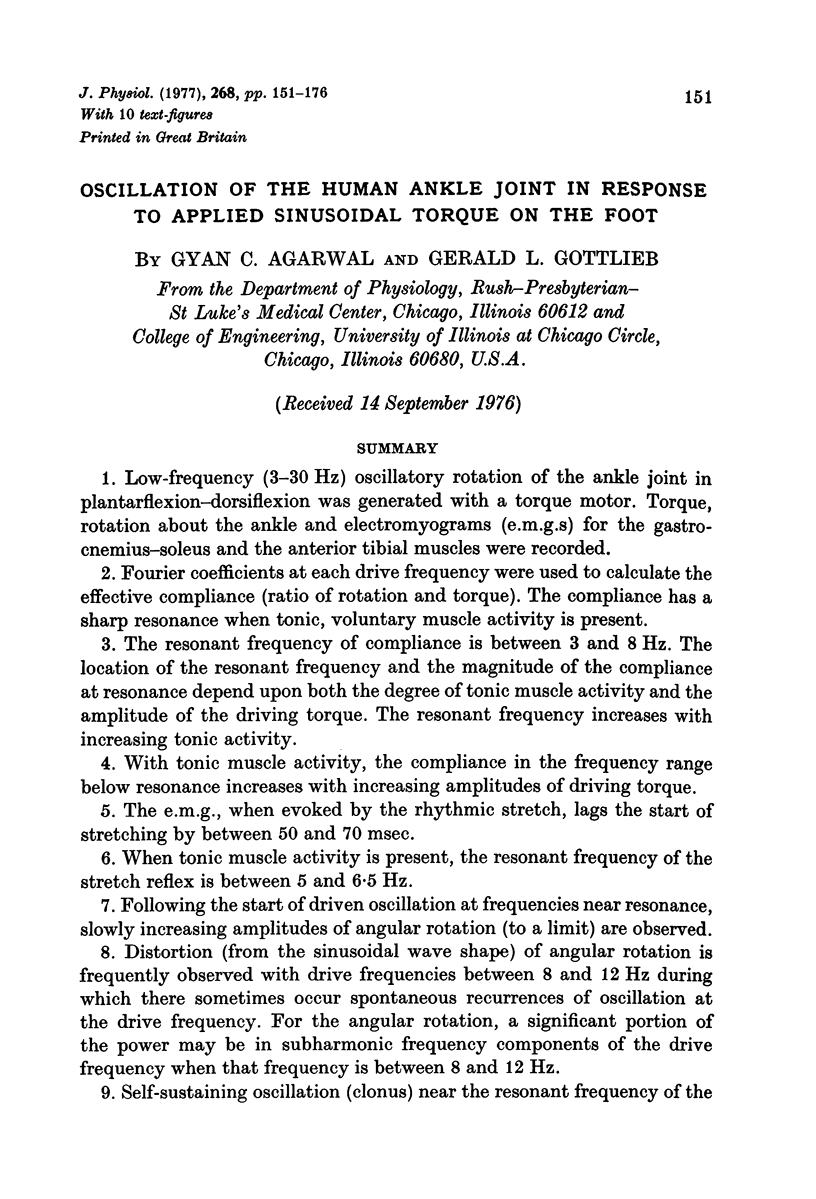
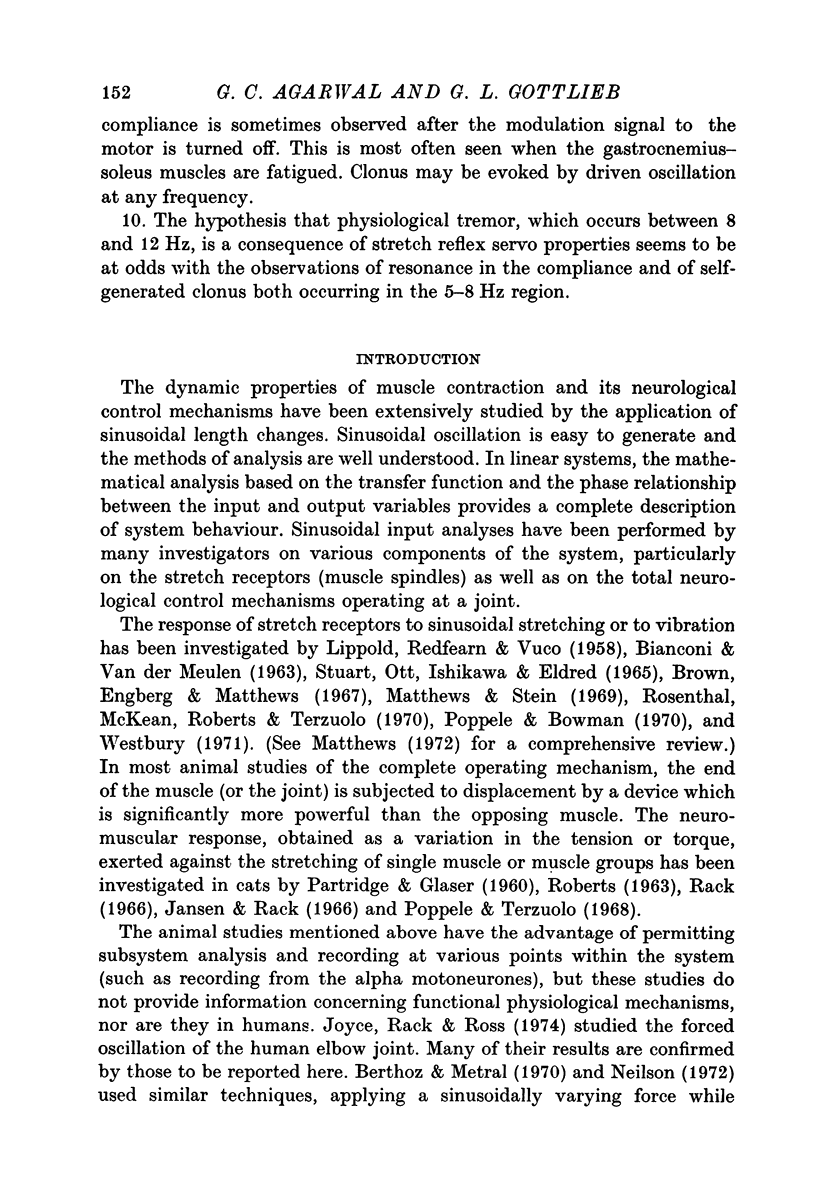
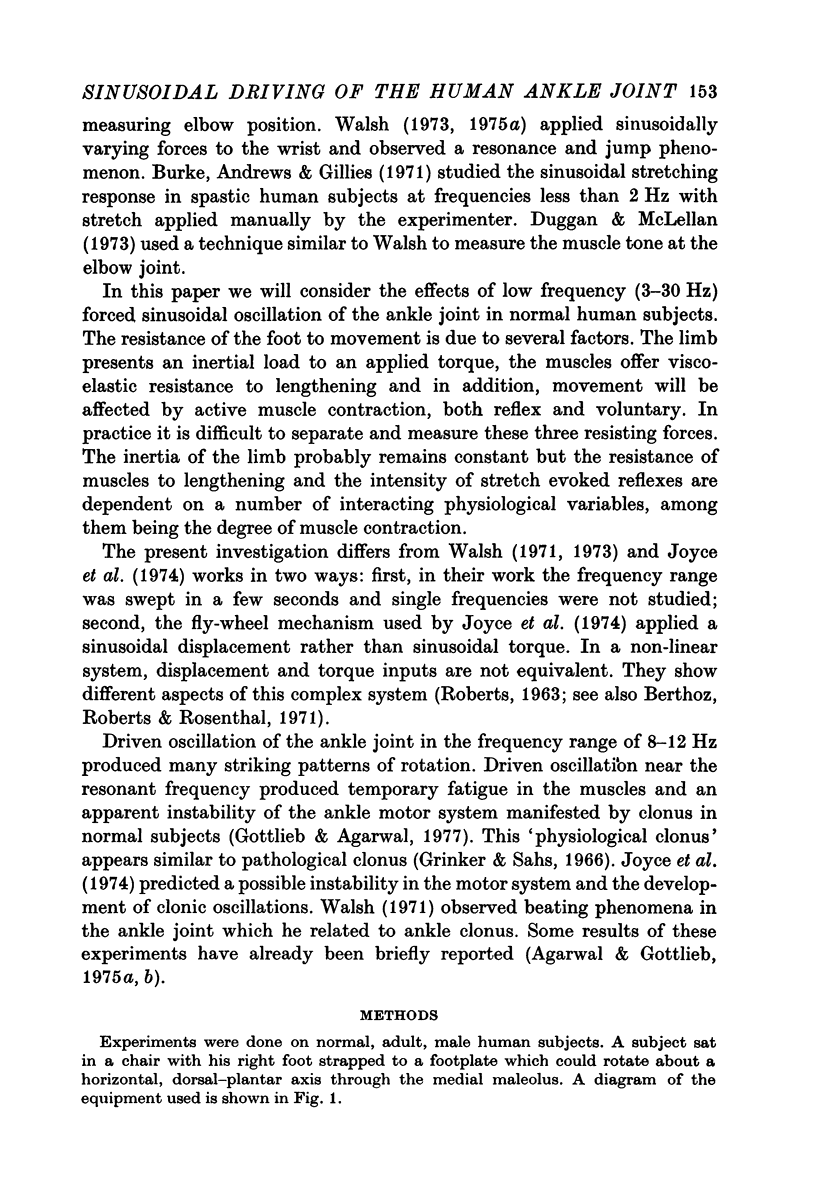
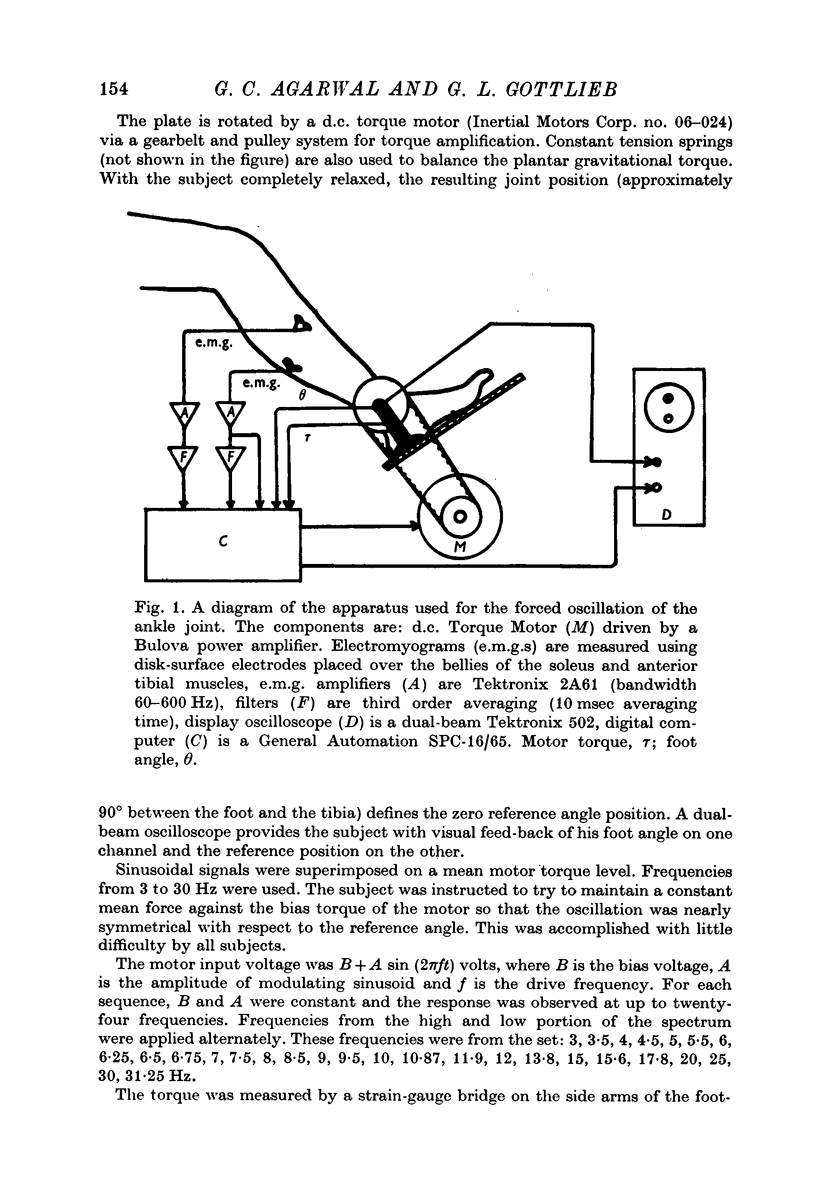
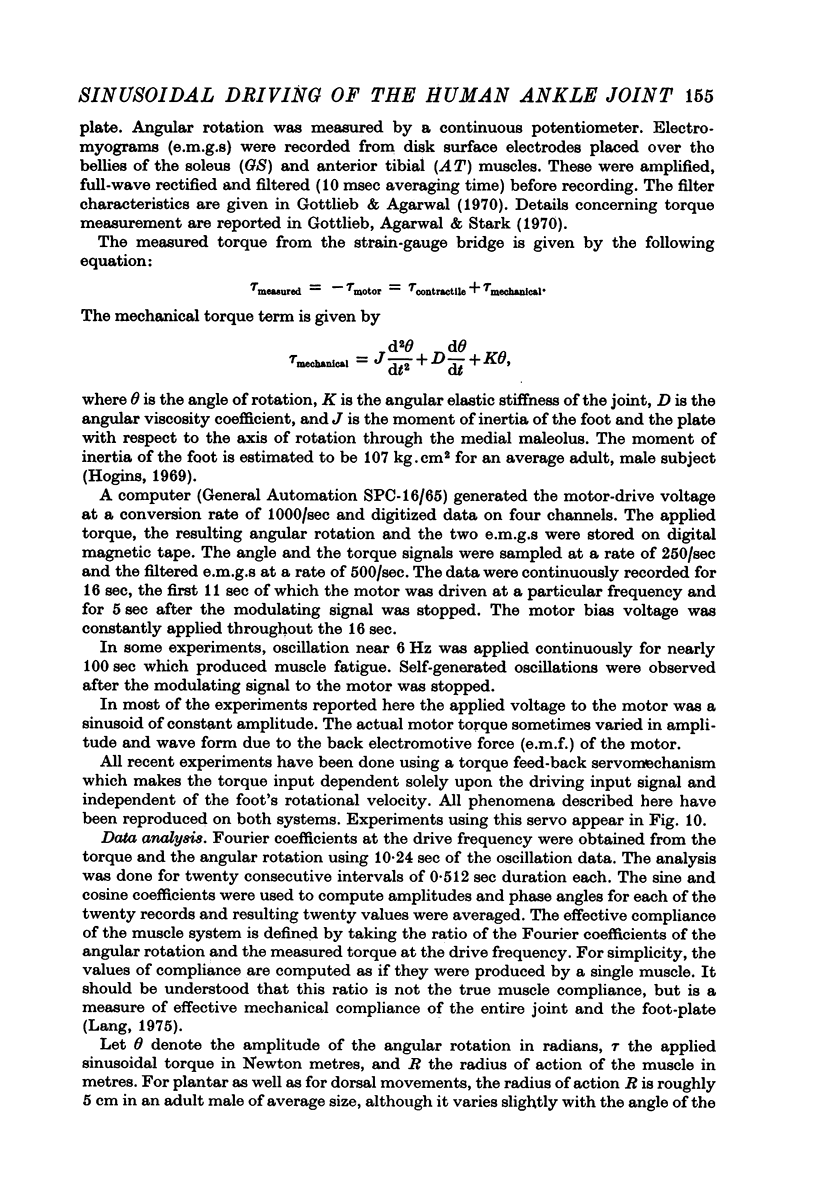


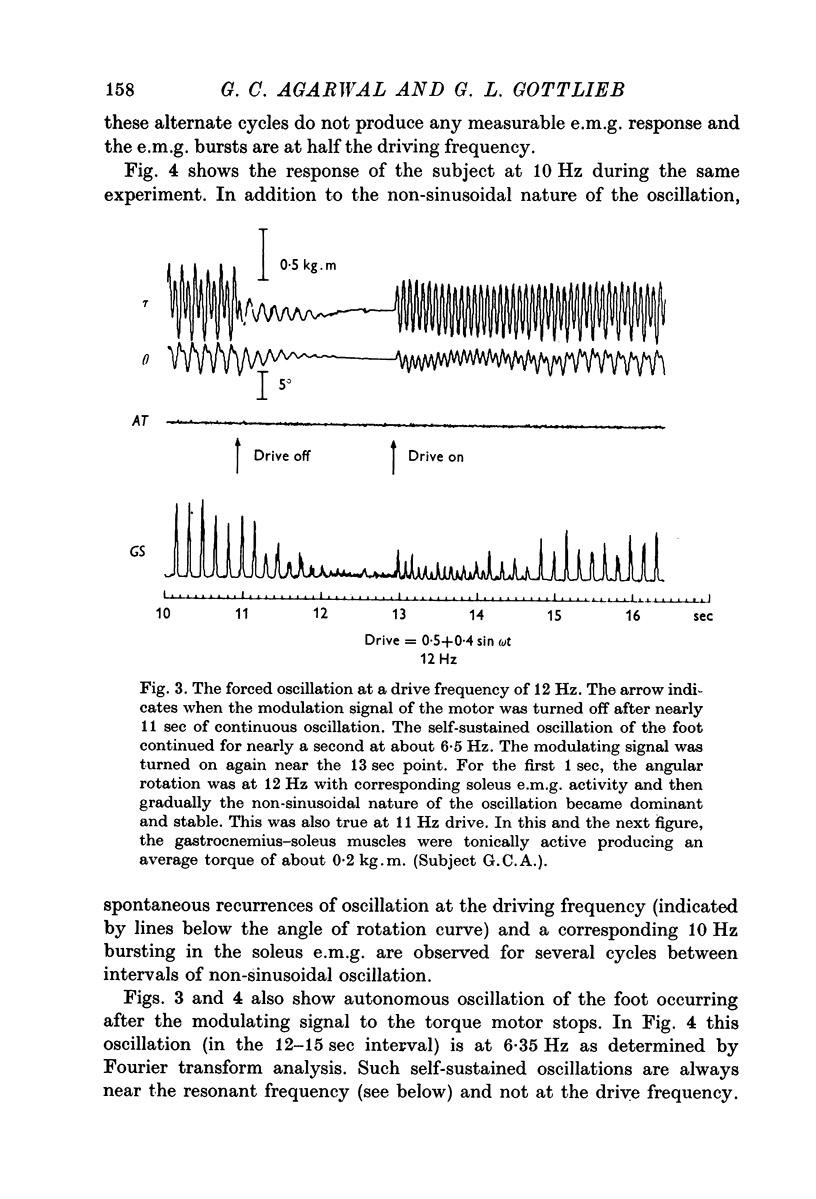
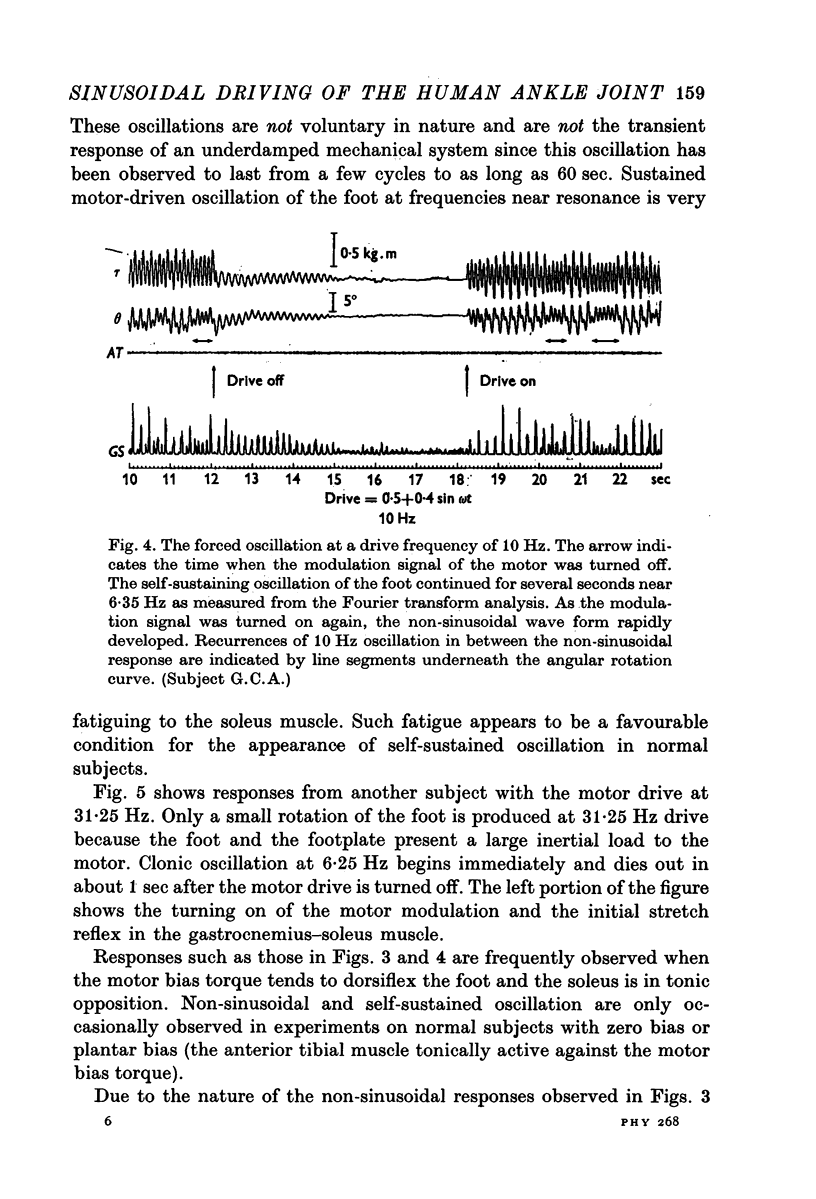

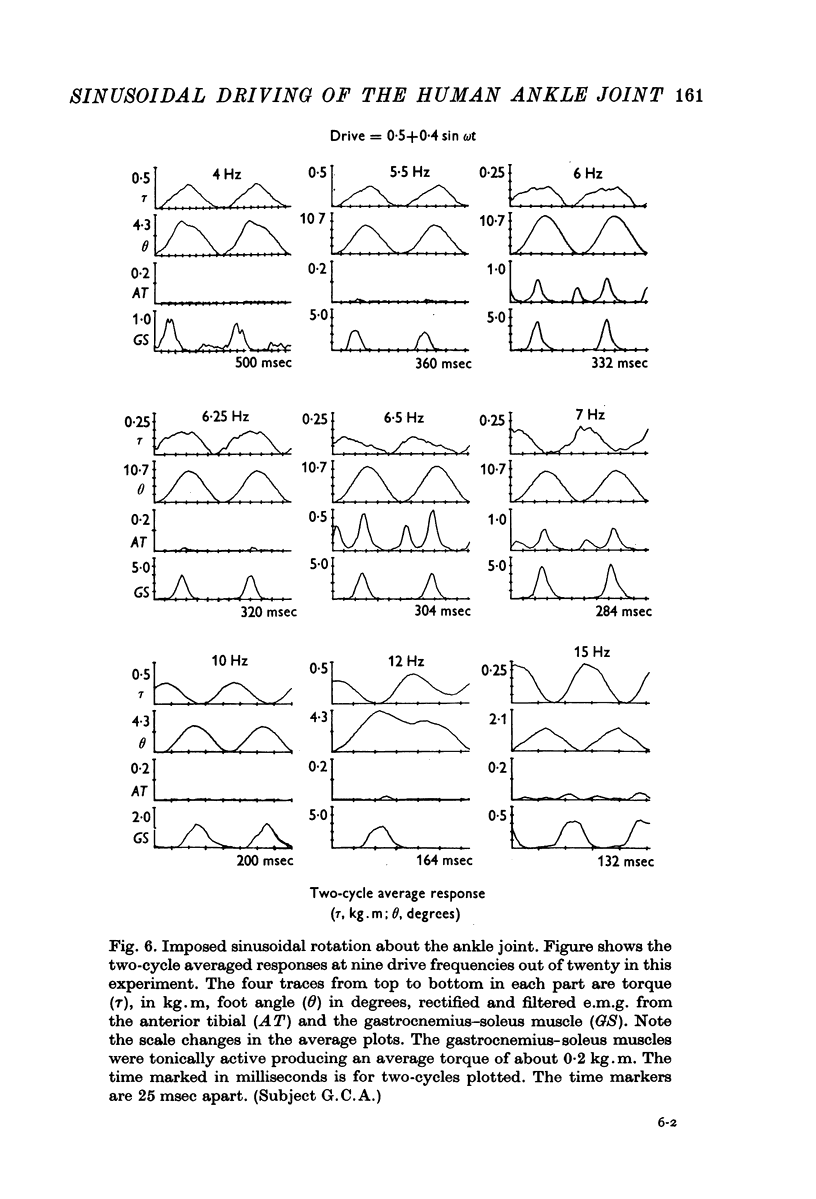
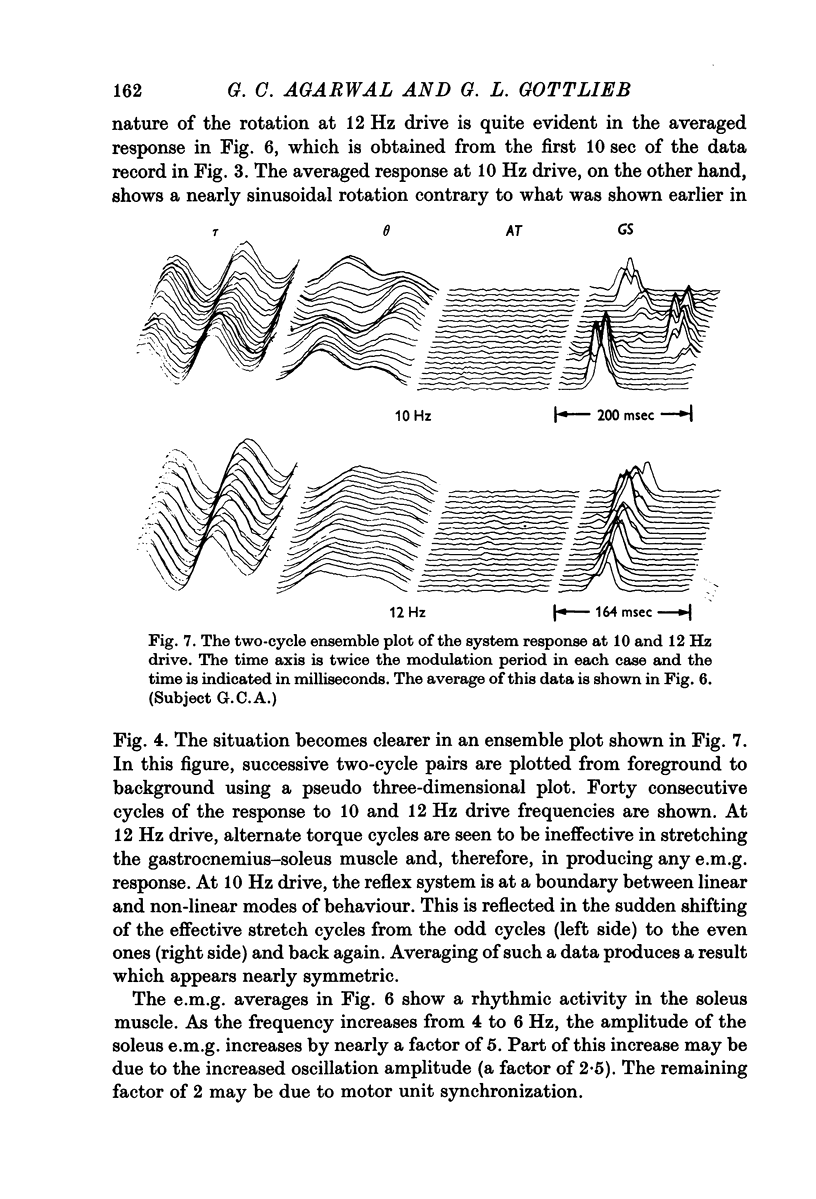


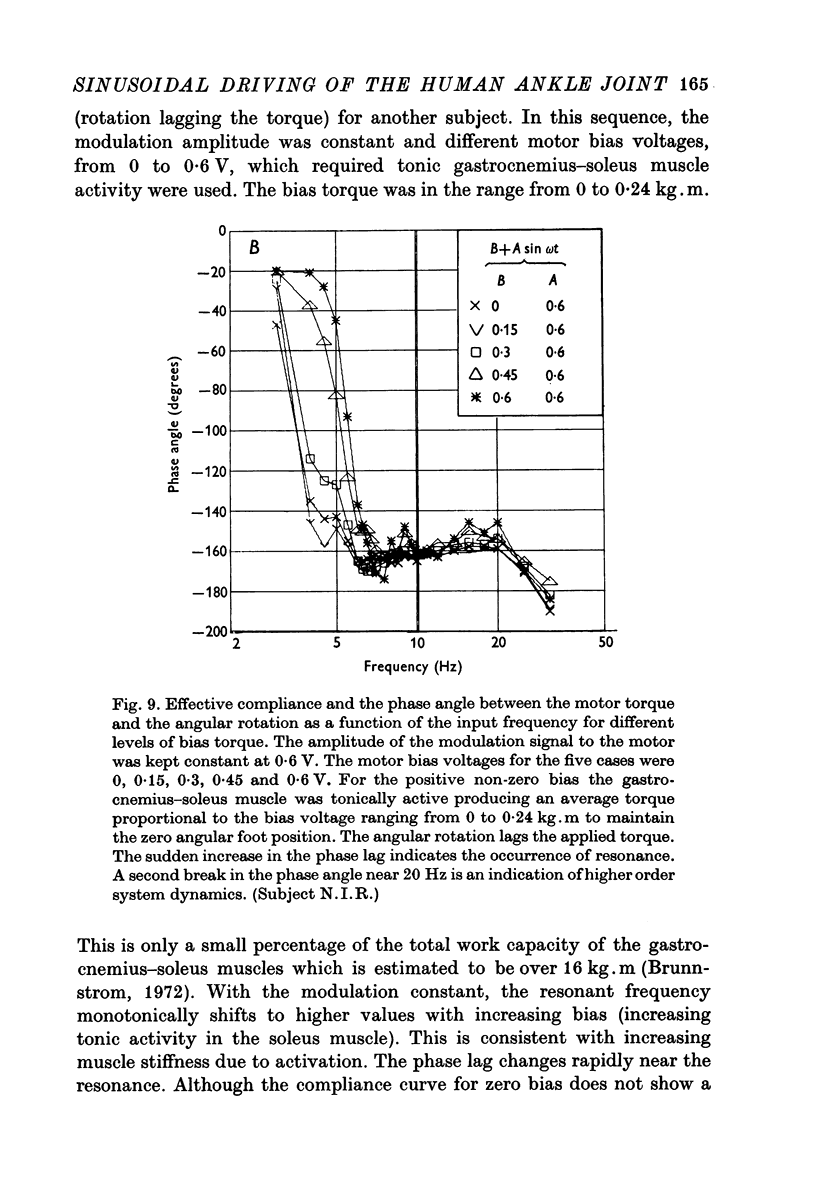
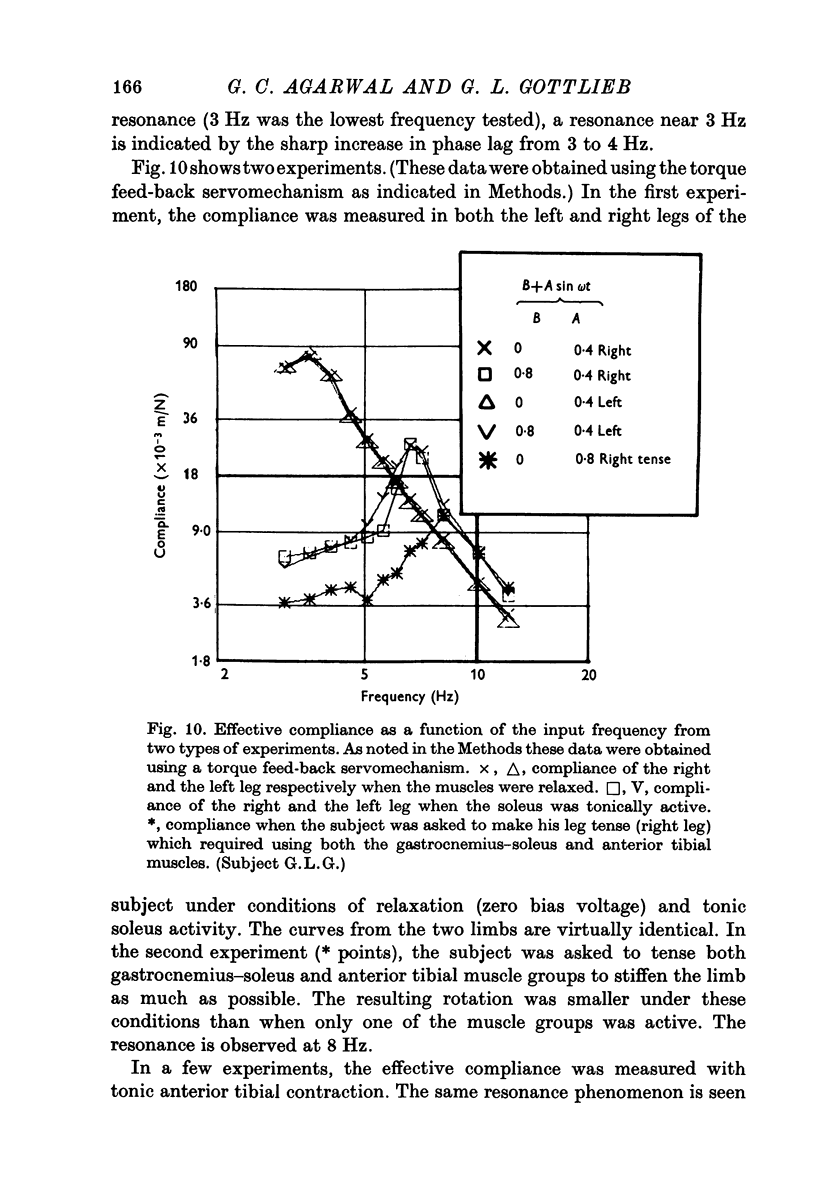


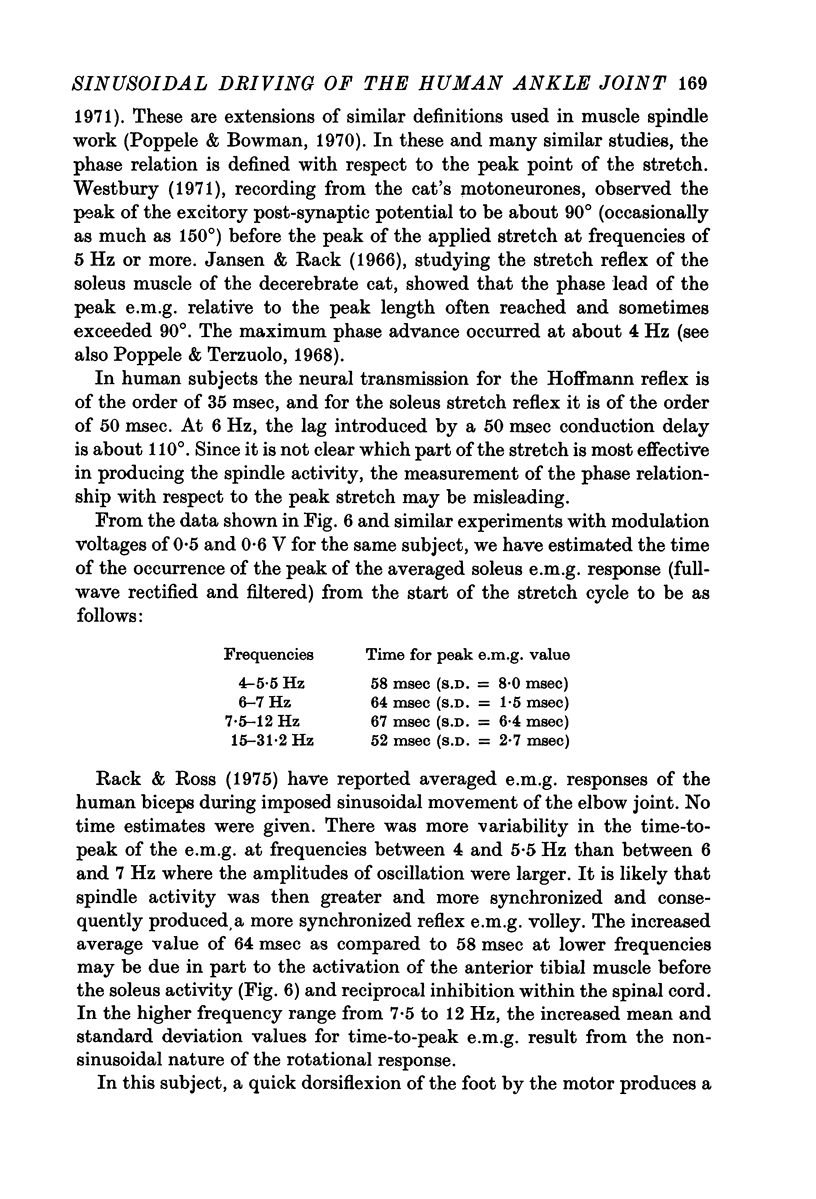
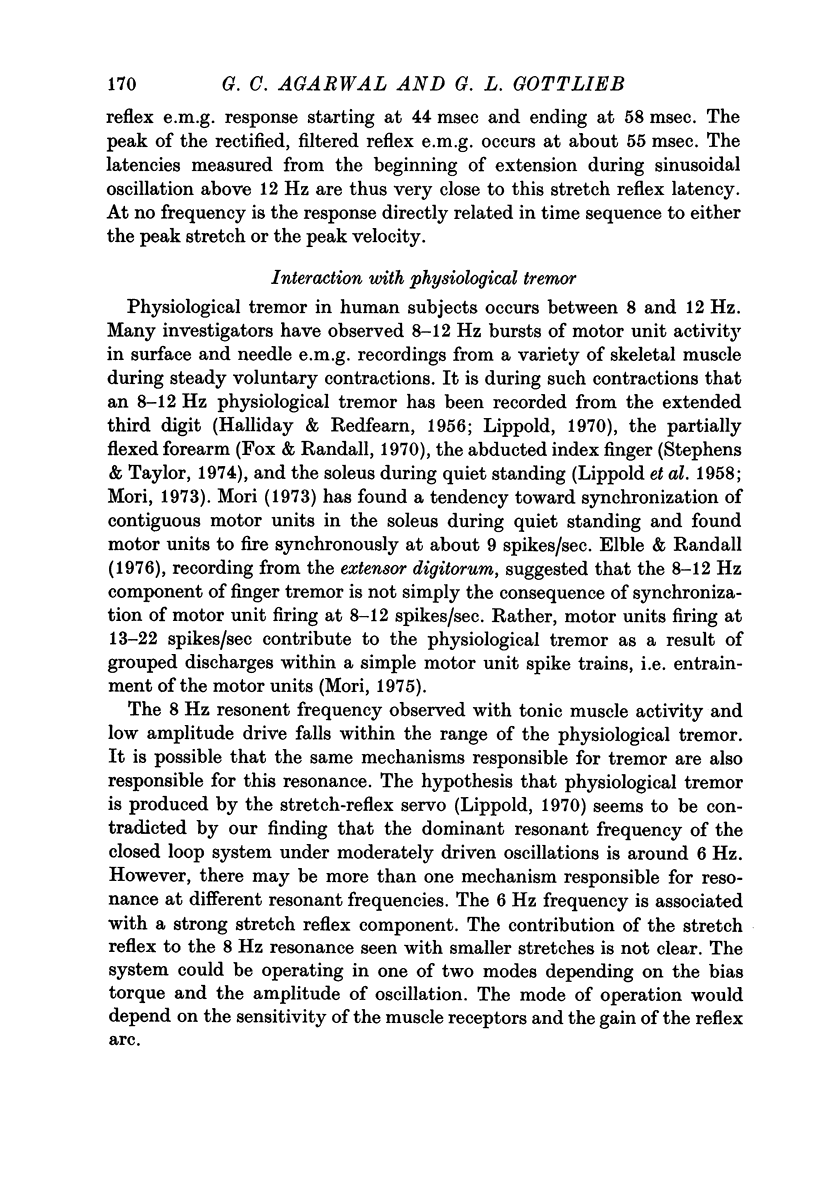

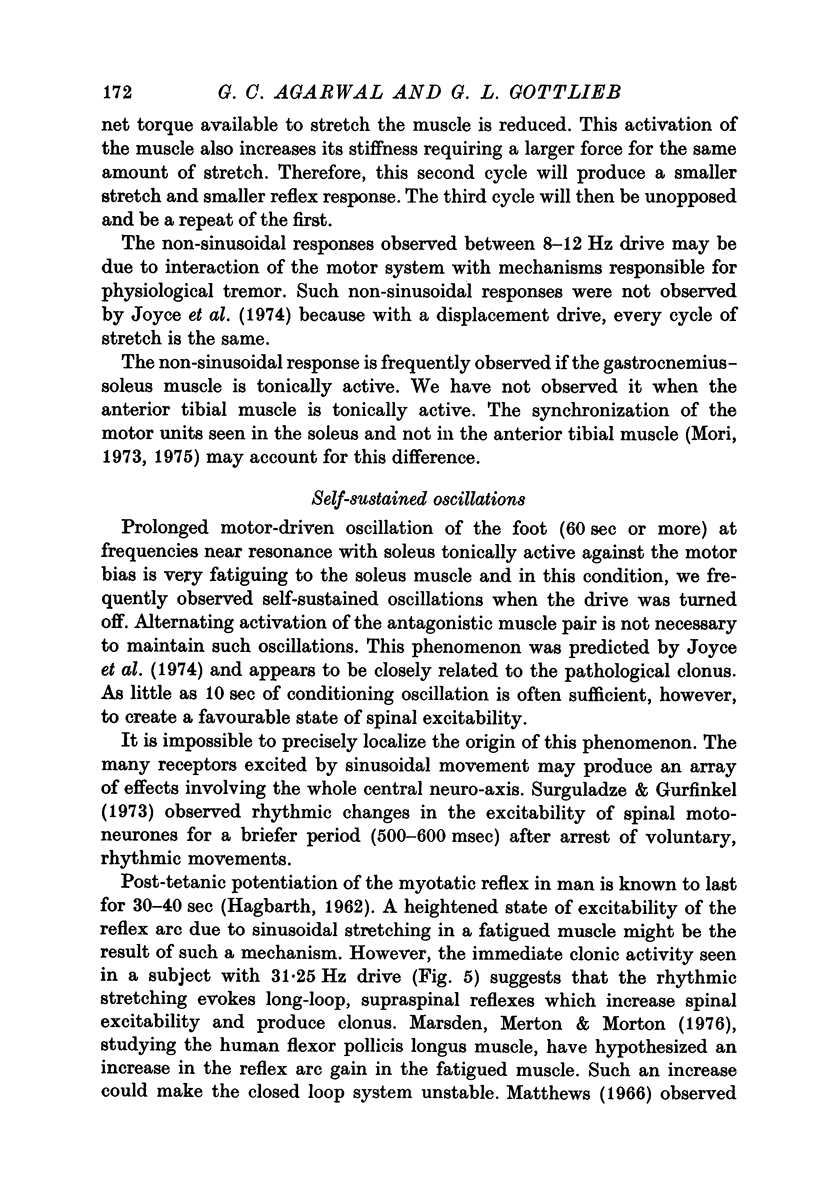
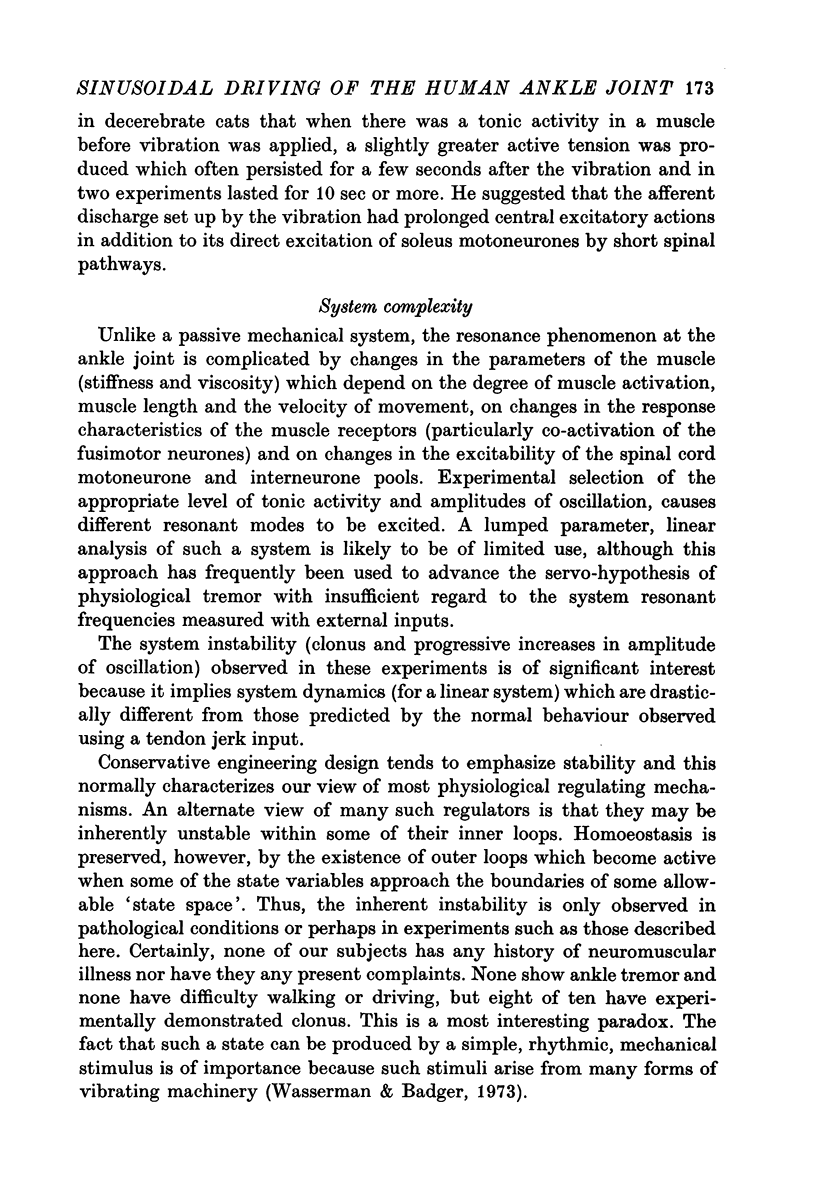

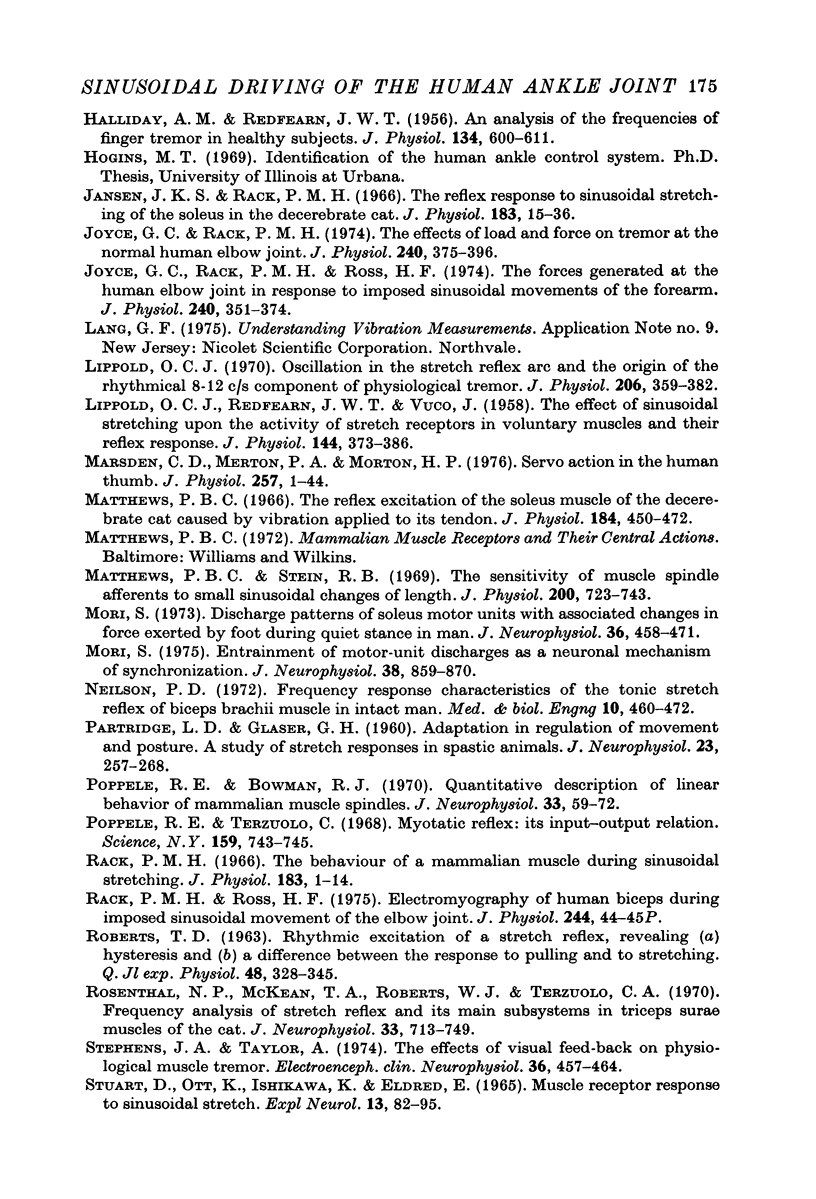

Selected References
These references are in PubMed. This may not be the complete list of references from this article.
- BIANCONI R., van der MEULEN J. The response to vibration of the end organs of mammalian muscle spindles. J Neurophysiol. 1963 Jan;26:177–190. doi: 10.1152/jn.1963.26.1.177. [DOI] [PubMed] [Google Scholar]
- Berthoz A., Metral S. Behavior of a muscular group subjected to a sinusoidal and trapezoidal variation of force. J Appl Physiol. 1970 Sep;29(3):378–384. doi: 10.1152/jappl.1970.29.3.378. [DOI] [PubMed] [Google Scholar]
- Berthoz A., Roberts W. J., Rosenthal N. P. Dynamic characteristics of stretch reflex using force inputs. J Neurophysiol. 1971 Jul;34(4):612–619. doi: 10.1152/jn.1971.34.4.612. [DOI] [PubMed] [Google Scholar]
- Brown M. C., Engberg I., Matthews P. B. The relative sensitivity to vibration of muscle receptors of the cat. J Physiol. 1967 Oct;192(3):773–800. doi: 10.1113/jphysiol.1967.sp008330. [DOI] [PMC free article] [PubMed] [Google Scholar]
- Buchthal F., Schmalbruch H. Contraction times and fibre types in intact human muscle. Acta Physiol Scand. 1970 Aug;79(4):435–452. doi: 10.1111/j.1748-1716.1970.tb04744.x. [DOI] [PubMed] [Google Scholar]
- Burke D., Andrews C. J., Gillies J. D. The reflex response to sinusoidal stretching in spastic man. Brain. 1971;94(3):455–470. doi: 10.1093/brain/94.3.455. [DOI] [PubMed] [Google Scholar]
- Duggan T. C., McLellan D. L. Technical contribution. Measurement of muscle tone: a method suitable for clinical use. Electroencephalogr Clin Neurophysiol. 1973 Dec;35(6):654–658. doi: 10.1016/0013-4694(73)90220-4. [DOI] [PubMed] [Google Scholar]
- Elble R. J., Randall J. E. Motor-unit activity responsible for 8- to 12-Hz component of human physiological finger tremor. J Neurophysiol. 1976 Mar;39(2):370–383. doi: 10.1152/jn.1976.39.2.370. [DOI] [PubMed] [Google Scholar]
- Fox J. R., Randall J. E. Relationship between forearm tremor and the biceps electromyogram. J Appl Physiol. 1970 Jul;29(1):103–108. doi: 10.1152/jappl.1970.29.1.103. [DOI] [PubMed] [Google Scholar]
- Gottlieb G. L., Agarwal G. C. Filtering of electromyographic signals. Am J Phys Med. 1970 Apr;49(2):142–146. [PubMed] [Google Scholar]
- Gottlieb G. L., Agarwal G. C., Stark L. Interactions between voluntary and postural mechanisms of thehuman motor system. J Neurophysiol. 1970 May;33(3):365–381. doi: 10.1152/jn.1970.33.3.365. [DOI] [PubMed] [Google Scholar]
- HAGBARTH K. E. Post-tetanic potentiation of myotatic reflexes in man. J Neurol Neurosurg Psychiatry. 1962 Feb;25:1–10. doi: 10.1136/jnnp.25.1.1. [DOI] [PMC free article] [PubMed] [Google Scholar]
- HALLIDAY A. M., REDFEARN J. W. An analysis of the frequencies of finger tremor in healthy subjects. J Physiol. 1956 Dec 28;134(3):600–611. doi: 10.1113/jphysiol.1956.sp005668. [DOI] [PMC free article] [PubMed] [Google Scholar]
- Hagbarth K. E., Wallen G., Löfstedt L. Muscle spindle activity in man during voluntary fast alternating movements. J Neurol Neurosurg Psychiatry. 1975 Jul;38(7):625–635. doi: 10.1136/jnnp.38.7.625. [DOI] [PMC free article] [PubMed] [Google Scholar]
- Jansen J. K., Rack P. M. The reflex response to sinusoidal stretching of soleus in the decerebrate cat. J Physiol. 1966 Mar;183(1):15–36. doi: 10.1113/jphysiol.1966.sp007849. [DOI] [PMC free article] [PubMed] [Google Scholar]
- Joyce G. C., Rack P. M., Ross H. F. The forces generated at the human elbow joint in response to imposed sinusoidal movements of the forearm. J Physiol. 1974 Jul;240(2):351–374. doi: 10.1113/jphysiol.1974.sp010614. [DOI] [PMC free article] [PubMed] [Google Scholar]
- Joyce G. C., Rack P. M. The effects of load and force on tremor at the normal human elbow joint. J Physiol. 1974 Jul;240(2):375–396. doi: 10.1113/jphysiol.1974.sp010615. [DOI] [PMC free article] [PubMed] [Google Scholar]
- LIPPOLD O. C., REDFEARN J. W., VUCO J. The effect of sinusoidal stretching upon the activity of stretch receptors in voluntary muscle and their reflex responses. J Physiol. 1958 Dec 30;144(3):373–386. doi: 10.1113/jphysiol.1958.sp006108. [DOI] [PMC free article] [PubMed] [Google Scholar]
- Lippold O. C. Oscillation in the stretch reflex arc and the origin of the rhythmical, 8-12 C-S component of physiological tremor. J Physiol. 1970 Feb;206(2):359–382. doi: 10.1113/jphysiol.1970.sp009018. [DOI] [PMC free article] [PubMed] [Google Scholar]
- Marsden C. D., Merton P. A., Morton H. B. Servo action in the human thumb. J Physiol. 1976 May;257(1):1–44. doi: 10.1113/jphysiol.1976.sp011354. [DOI] [PMC free article] [PubMed] [Google Scholar]
- Matthews P. B., Stein R. B. The sensitivity of muscle spindle afferents to small sinusoidal changes of length. J Physiol. 1969 Feb;200(3):723–743. doi: 10.1113/jphysiol.1969.sp008719. [DOI] [PMC free article] [PubMed] [Google Scholar]
- Matthews P. B. The reflex excitation of the soleus muscle of the decerebrate cat caused by vibbration applied to its tendon. J Physiol. 1966 May;184(2):450–472. doi: 10.1113/jphysiol.1966.sp007926. [DOI] [PMC free article] [PubMed] [Google Scholar]
- Mori S. Discharge patterns of soleus motor units with associated changes in force exerted by foot during quiet stance in man. J Neurophysiol. 1973 May;36(3):458–471. doi: 10.1152/jn.1973.36.3.458. [DOI] [PubMed] [Google Scholar]
- Mori S. Entrainment of motor-unit discharges as a neuronal mechanism of synchronization. J Neurophysiol. 1975 Jul;38(4):859–870. doi: 10.1152/jn.1975.38.4.859. [DOI] [PubMed] [Google Scholar]
- Neilson P. D. Frequency-response characteristics of the tonic stretch reflexes of biceps brachii muscle in intact man. Med Biol Eng. 1972 Jul;10(4):460–472. doi: 10.1007/BF02474194. [DOI] [PubMed] [Google Scholar]
- PARTRIDGE L. D., GLASER G. H. Adaptation in regulation of movement and posture. A study of stretch responses in spastic animals. J Neurophysiol. 1960 May;23:257–268. doi: 10.1152/jn.1960.23.3.257. [DOI] [PubMed] [Google Scholar]
- Poppele R. E., Bowman R. J. Quantitative description of linear behavior of mammalian muscle spindles. J Neurophysiol. 1970 Jan;33(1):59–72. doi: 10.1152/jn.1970.33.1.59. [DOI] [PubMed] [Google Scholar]
- Poppele R. E., Terzuolo C. A. Myotatic reflex: its input-output relation. Science. 1968 Feb 16;159(3816):743–745. doi: 10.1126/science.159.3816.743. [DOI] [PubMed] [Google Scholar]
- ROBERTS T. D. RHYTHMIC EXCITATION OF A STRETCH REFLEX, REVEALING (A) HYSTERESIS AND (B) A DIFFERENCE BETWEEN THE RESPONSES TO PULLING AND TO STRETCHING. Q J Exp Physiol Cogn Med Sci. 1963 Oct;48:328–345. doi: 10.1113/expphysiol.1963.sp001676. [DOI] [PubMed] [Google Scholar]
- Rack M. H., Ross H. F. Electromyography of human biceps during imposed sinusoidal movement of the elbow joint. J Physiol. 1975 Jan;244(1):44P–45P. [PubMed] [Google Scholar]
- Rack P. M. The behaviour of a mammalian muscle during sinusoidal stretching. J Physiol. 1966 Mar;183(1):1–14. doi: 10.1113/jphysiol.1966.sp007848. [DOI] [PMC free article] [PubMed] [Google Scholar]
- Rosenthal N. P., McKean T. A., Roberts W. J., Terzuolo C. A. Frequency analysis of stretch reflex and its main subsystems in triceps surae muscles of the cat. J Neurophysiol. 1970 Nov;33(6):713–749. doi: 10.1152/jn.1970.33.6.713. [DOI] [PubMed] [Google Scholar]
- STUART D., OTT K., ISHIKAWA K., ELDRED E. MUSCLE RECEPTOR RESPONSES TO SINUSOIDAL STRETCH. Exp Neurol. 1965 Sep;13:82–95. doi: 10.1016/0014-4886(65)90007-5. [DOI] [PubMed] [Google Scholar]
- Stephens J. A., Taylor A. The effect of visual feedback on physiological muscle tremor. Electroencephalogr Clin Neurophysiol. 1974 May;36(5):457–464. doi: 10.1016/0013-4694(74)90202-8. [DOI] [PubMed] [Google Scholar]
- Surguladze T. D., Gurfinkel' V. S. Sledovye izmeneniia vozbudimosti spinnogo mozga posle prekrashcheniia ritmicheskikh dvizhenii. Biofizika. 1973 Sep-Oct;18(5):947–948. [PubMed] [Google Scholar]
- WILKIE D. R. The relation between force and velocity in human muscle. J Physiol. 1949 Dec;110(3-4):249–280. doi: 10.1113/jphysiol.1949.sp004437. [DOI] [PMC free article] [PubMed] [Google Scholar]
- Walsh E. G. Ankle clonus--an autonomous central pace-maker? J Physiol. 1971 Jan;212(2):38P–39P. [PubMed] [Google Scholar]
- Walsh E. G. Motion at the wrist induced by rhythmic forces. J Physiol. 1973 Apr;230(1):44P–45P. [PubMed] [Google Scholar]
- Walsh E. G. Proceedings: Jump effect at the wrist - model using light or non-linear damping. J Physiol. 1975 Jun;248(1):19P–20P. [PubMed] [Google Scholar]
- Walsh E. G. Resonance of the wrist--a 'jump' effect. J Physiol. 1975 Feb;245(2):69P–70P. [PubMed] [Google Scholar]
- Westbury D. R. The response of alpha-motoneurones of the cat to sinusoidal movements of the muscles they innervate. Brain Res. 1971 Jan 8;25(1):75–86. doi: 10.1016/0006-8993(71)90568-3. [DOI] [PubMed] [Google Scholar]


